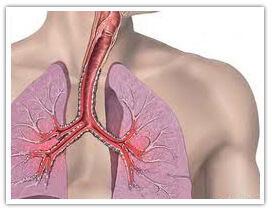 A detailed description and differential diagnosis of a group of disorders involving respiratory distress (dyspnea) is given in all three of the major Ayurvedic compendiums. These diseases are collectively known as svasa roga , of which five varieties are described. These include: maha svasa, urdhva svasa, chinna svasa, ksudra svasa, and tamaka svasa. The last variety, tamaka svasa , corresponds to chronic persistent bronchial asthma of allopathic medicine.Ayurveda has treatment for chronic asthma. In Ayurveda, it is considered the only type of respiratory distress which can be controlled, and then only with diligence on the part of the patient and physician. In striking similarity to the modern allopathic description, tamaka svasa is defined in Ayurveda as a chronic and recurring condition characterized by dyspnea, cough, airflow obstruction, and wheezing. Although the concept of atopy and hyperreactivity were unknown, Ayurveda was clear on its understanding of this condition as multifactorial, including environmental and emotional factors. A detailed description and differential diagnosis of a group of disorders involving respiratory distress (dyspnea) is given in all three of the major Ayurvedic compendiums. These diseases are collectively known as svasa roga , of which five varieties are described. These include: maha svasa, urdhva svasa, chinna svasa, ksudra svasa, and tamaka svasa. The last variety, tamaka svasa , corresponds to chronic persistent bronchial asthma of allopathic medicine.Ayurveda has treatment for chronic asthma. In Ayurveda, it is considered the only type of respiratory distress which can be controlled, and then only with diligence on the part of the patient and physician. In striking similarity to the modern allopathic description, tamaka svasa is defined in Ayurveda as a chronic and recurring condition characterized by dyspnea, cough, airflow obstruction, and wheezing. Although the concept of atopy and hyperreactivity were unknown, Ayurveda was clear on its understanding of this condition as multifactorial, including environmental and emotional factors.
The prevalence of both adult and childhood asthma is reported to be increasing worldwide. Up to 10% of people have experienced a documented episode of asthma. In the United States, approximately 12 million individuals have been diagnosed with asthma. Between 1982 and 1992 the prevalence of asthma increased from 34.7 to 49.4 per 1000. In addition the death rate from this condition actually increased from 13.4 to 18.8 per million. The mortality rate was five times higher in African Americans than in Caucasians.
Vagbhata gives a clear explanation of the causes and evolution of asthma. In all cases there is an antecedent period of aggravation of both Vata and Kapha doshas. A very great number of factors can be responsible for aggravating these two doshas, and to list them all would not be possible. However several vitiating factors are specifically mentioned by Vagbhata and therefore merit mention. He cites chronic diarrhea due to indigestion which goes untreated, excessive vomiting, poisons, anemia, fevers, excessive exposure to dust, smoke or strong wind, trauma to the vital organs, and drinking very cold water.
At this early stage in the disease process, if these signs and symptoms are recognized and properly treated by pacification and elimination of the aggravated doshas, the disease (asthma) will not appear. However, if left untreated and if further aggravated, Kapha will obstruct the movement of Vata in the chest area. Due to this obstruction, Vata spills out of its normal channels ( srotas ) and spreads in all directions, carrying with it the vitiated Kapha dosha. As a result, the three major channels in the chest region become blocked and, to a greater or lesser degree, dysfunctional. These channels are Prana Vaha Srota (governs respiration), Anna Vaha Srota (governs digestion of food), and Udaka Vaha Srota (governs water distribution). At this point the disease is no longer in its incipient stage and asthma --tamaka svasa-- has manifested.
The role of psychological stress in asthma is important but not yet completely understood. Not only is there emerging evidence that stress can precipitate asthmatic exacerbations but also that it may be an independent risk factor in the prevalence of the disease. [1] The mechanisms involved in this association have not yet been fully defined and may involve increased production of proinflammatory cytokines. [2]
Signs and Symptoms of Asthma :
The signs and symptoms of this disease are vividly enumerated in both the Caraka Samhita and the Astanga Hridayam and are worth noting:
- The breathing becomes very fast and audible
- The patient becomes tremulous on occasion
- There is chronic nasal discharge and stiffness of the head and neck
- There is excessive thirst
- The patient coughs constantly, sometimes to the point of senselessness
- If the obstructing phlegm does not come out during the cough, the patient becomes exceedingly miserable and after expectoration there is relief for some period of time.
- The throat becomes inflamed and he speaks only with great difficulty
- Due to his dyspnea (difficulty breathing), he does not sleep even after lying down in bed.
- Breathing is difficult while lying and there is some relief with sitting
- The patient desires to have hot things
- The eyeballs are gazing upwards (i.e. wide open) and perspiration appears on the forehead
- The mouth is dry
- There are periods of frequent attacks of dyspnea followed by periods of no attacks
- The condition is aggravated by the onset of clouds in the sky, rain, cold breeze, drinking cold water, wind coming from the east, and regimens and diets which are cold in quality.
The clinician trying to establish a diagnosis of asthma should determine that:
- Episodic symptoms of airflow obstruction are present.
- Airflow obstruction is at least partially reversible.
- Alternative diagnoses are excluded.
A careful medical history, physical examination, pulmonary function tests, and additional tests will provide the information needed to ensure a correct diagnosis of asthma. Clinical judgment is needed in conducting the assessment for asthma. Patients with asthma are heterogeneous and present signs and symptoms that vary widely from patient to patient as well as within each patient over time. However, there are signs and symptoms which are common to most patients in whom the diagnosis of asthma is made.
Prognosis
 Although a full description of the other four types of svasa roga (dyspnea, or difficult breathing) is beyond the scope of this paper, a few comments are in order. Ksudra svasa is the mildest form of svasa roga it roughly corresponds to mild intermittent asthma and is said to be curable. Tamaka svasa (asthma) is the next mildest form of svasa roga yet it is considered difficult to cure. It roughly corresponds to mild persistent asthma in the modern allopathic classification scheme. Cure is possible if the disease is of recent origin or if it occurs in an otherwise strong and health individual. In a weak individual only palliation (i.e. alleviation) should be attempted. The other three types of svasa roga, namely maha svasa, urdhva svasa, and chinna svasa loosely correspond to other more severe forms of obstructive pulmonary disease, are incurable, and in time result in the premature demise of the patient. Although a full description of the other four types of svasa roga (dyspnea, or difficult breathing) is beyond the scope of this paper, a few comments are in order. Ksudra svasa is the mildest form of svasa roga it roughly corresponds to mild intermittent asthma and is said to be curable. Tamaka svasa (asthma) is the next mildest form of svasa roga yet it is considered difficult to cure. It roughly corresponds to mild persistent asthma in the modern allopathic classification scheme. Cure is possible if the disease is of recent origin or if it occurs in an otherwise strong and health individual. In a weak individual only palliation (i.e. alleviation) should be attempted. The other three types of svasa roga, namely maha svasa, urdhva svasa, and chinna svasa loosely correspond to other more severe forms of obstructive pulmonary disease, are incurable, and in time result in the premature demise of the patient.
The physicians of Ayusya Clinic has started the treatment while an individual's constitutional type must always be kept in mind when developing a treatment plan for any disease, asthma is nevertheless generally treated by pacifying Vata and Kapha doshas. The treatment will always include two main strategies:
a) purification therapies (panchakarma) to eliminate the vitiated doshas.
b) herbal therapies to help re-establish normal physiological function in the affected tissues and organs.
However asthma is highly variable in its course and clinicians need to tailor their treatment plans to the needs of each individual patient. The general Ayurvedic principle is to initially gain control of the disease as quickly possible with strong Vata and Kapha purification measures which are then followed with appropriate herbal therapies.
Ayurvedic Treatment for Asthma
Purification Therapies
• Oleation and Fomentation Procedures
Patients must first undergo oleation therapy ( snehana ) this includes both external and internal forms of oil treatment. External oleation by daily oil massage should be administered first, for 7-10 days. The best oils in tamaka svasa are: narayana oil, talispatra oil, amra oil (from mango seeds), or chandrabala oil. Next, patients undergo internal oleation with daily intake of an appropriate unctuous substance for 3-7 days this is usually pure or medicated cow's ghee which should be at least six months old. During this period, patients have simultaneous sweat, or fomentation, therapy ( swedana ). This usually includes both general "steam box" treatments as well as pinda sweda . The latter therapy involves the placement of hot boluses of rice and special herbs wrapped in a cloth over certain points of the body. These points are called marma sthula and are similar to the Chinese acupuncture points.
• Laxative Procedure
Following snehana and swedana therapies, a one-time virechana , or laxative therapy, is administered. Castor oil ( Ricinis communis ) in a dose of 2-3 tablespoons is generally used for this.
• Therapeutic Vomiting Procedure
Finally, vamana , or theraputic vomiting therapy should be initiated this is the most important therapy in diseases involving respiratory distress. This usually involves three consecutive mornings when, following a light breakfast, patients are given an emetic herb (i.e. madana phala) and then asked to fill the stomach with cool water or milk to induce vomiting. Correctly performed, this is not at all uncomfortable and does not produce nausea. Weaker, very elderly, acutely ill, or cardiac patients however should not be given vamana therapy.
|


 (0)9831775590
Book appointment
(0)9831775590
Book appointment
 (0)9831775590
Book appointment
(0)9831775590
Book appointment
 (0)9831775590
Book appointment
(0)9831775590
Book appointment
 (0)9831775590
(0)9831775590
 (0)9831775590
(0)9831775590
 (0)9831775590
(0)9831775590



 A detailed description and differential diagnosis of a group of disorders involving respiratory distress (dyspnea) is given in all three of the major Ayurvedic compendiums. These diseases are collectively known as svasa roga , of which five varieties are described. These include: maha svasa, urdhva svasa, chinna svasa, ksudra svasa, and tamaka svasa. The last variety, tamaka svasa , corresponds to chronic persistent bronchial asthma of allopathic medicine.Ayurveda has treatment for chronic asthma. In Ayurveda, it is considered the only type of respiratory distress which can be controlled, and then only with diligence on the part of the patient and physician. In striking similarity to the modern allopathic description, tamaka svasa is defined in Ayurveda as a chronic and recurring condition characterized by dyspnea, cough, airflow obstruction, and wheezing. Although the concept of atopy and hyperreactivity were unknown, Ayurveda was clear on its understanding of this condition as multifactorial, including environmental and emotional factors.
A detailed description and differential diagnosis of a group of disorders involving respiratory distress (dyspnea) is given in all three of the major Ayurvedic compendiums. These diseases are collectively known as svasa roga , of which five varieties are described. These include: maha svasa, urdhva svasa, chinna svasa, ksudra svasa, and tamaka svasa. The last variety, tamaka svasa , corresponds to chronic persistent bronchial asthma of allopathic medicine.Ayurveda has treatment for chronic asthma. In Ayurveda, it is considered the only type of respiratory distress which can be controlled, and then only with diligence on the part of the patient and physician. In striking similarity to the modern allopathic description, tamaka svasa is defined in Ayurveda as a chronic and recurring condition characterized by dyspnea, cough, airflow obstruction, and wheezing. Although the concept of atopy and hyperreactivity were unknown, Ayurveda was clear on its understanding of this condition as multifactorial, including environmental and emotional factors.
 Although a full description of the other four types of svasa roga (dyspnea, or difficult breathing) is beyond the scope of this paper, a few comments are in order. Ksudra svasa is the mildest form of svasa roga it roughly corresponds to mild intermittent asthma and is said to be curable. Tamaka svasa (asthma) is the next mildest form of svasa roga yet it is considered difficult to cure. It roughly corresponds to mild persistent asthma in the modern allopathic classification scheme. Cure is possible if the disease is of recent origin or if it occurs in an otherwise strong and health individual. In a weak individual only palliation (i.e. alleviation) should be attempted. The other three types of svasa roga, namely maha svasa, urdhva svasa, and chinna svasa loosely correspond to other more severe forms of obstructive pulmonary disease, are incurable, and in time result in the premature demise of the patient.
Although a full description of the other four types of svasa roga (dyspnea, or difficult breathing) is beyond the scope of this paper, a few comments are in order. Ksudra svasa is the mildest form of svasa roga it roughly corresponds to mild intermittent asthma and is said to be curable. Tamaka svasa (asthma) is the next mildest form of svasa roga yet it is considered difficult to cure. It roughly corresponds to mild persistent asthma in the modern allopathic classification scheme. Cure is possible if the disease is of recent origin or if it occurs in an otherwise strong and health individual. In a weak individual only palliation (i.e. alleviation) should be attempted. The other three types of svasa roga, namely maha svasa, urdhva svasa, and chinna svasa loosely correspond to other more severe forms of obstructive pulmonary disease, are incurable, and in time result in the premature demise of the patient.